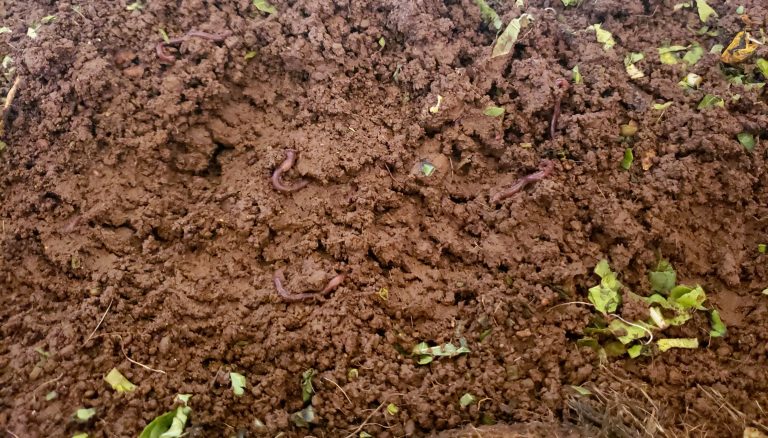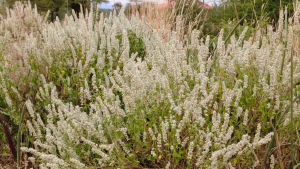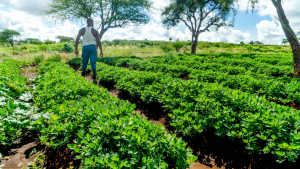
Soil health Conservation Through No Tillage
Our decision to forgo traditional tillage practices stems from a deep-seated understanding of soil dynamics. Tilling disrupts the soil’s natural composition, leading to erosion, compaction, and loss of valuable nutrients. Moreover, it disturbs the intricate web of soil microorganisms essential for nutrient cycling and plant health. No-tillage, on the other hand, maintains soil structure, promotes water infiltration, and mitigates erosion, thus laying the groundwork for sustainable agricultural practices.
Our Experience: As an organic farm committed to sustainability, we embraced no-tillage from the start. In 2022, we started Ambokili Farm on a dust-laden, semi-arid landscape in Kimana town. The land was damaged, with gullies as deep as 2 meters and sheet erosion that had stripped the soil bare. One of the reasons for the poor state of the land is tillage that left the soil loose and exposed to agents of erosion. The results have been remarkable. There’s minimal erosion and we’ve managed to restore 9 acres damaged by sheet and gulley erosion. We have witnessed firsthand the rejuvenation of our soil health. Our crops thrive in nutrient-rich soil, and erosion has become a relic of the past. This has translated to healthier crops, reduced pest pressure, and ultimately, better yields. Not only have we bolstered our Farm’s resilience to environmental challenges, but we have also forged a path towards a more sustainable future.
Why No-Tillage? In a world grappling with the repercussions of climate change and diminishing natural resources, the adoption of no-tillage agriculture should be a commitment- to nurture the very foundation of our food system: healthy soil. It is incumbent upon us to embrace practices that safeguard soil health for generations to come and herald a paradigm shift towards sustainable agriculture.
If you’re a farmer, more so an organic farmer, consider giving no-tillage a try. The initial learning curve may exist, but the long-term benefits to your soil, your crops, and ultimately, our planet are immeasurable. A good place to start is understanding what no-tillage is and the benefits.
Definition
No-tillage is a sustainable agricultural technique that eliminates the mechanical disturbance of the soil. Instead of churning the earth with ploughs, rototillers and discs, seeds are planted directly into the undisturbed ground, often through specialised equipment. This mimics natural ecosystems where fallen leaves and plant matter create a protective layer on the soil surface.
Direct seeding and its benefits
Direct seeding involves sowing seeds directly into untilled soil without disturbing its surface. This method has several benefits:
- Conservation of Moisture: By leaving the soil undisturbed, direct seeding helps retain moisture, crucial for plant survival especially, in arid environments.
- Protection from Erosion: Intact soil surfaces reduce the risk of erosion by wind and water, safeguarding seeds and seedlings.
- Improved Germination: Direct seeding allows seeds to make direct contact with the soil, enhancing germination rates and early plant establishment.
- Enhanced Soil Structure: Soil structure refers to the arrangement of soil particles into aggregates or clumps, interspersed with pore spaces. This structure is crucial for water retention, aeration, and root penetration. No-tillage preserves this structure by:
- Maintaining Soil Aggregates
- Enhancing Soil Biology: No-tillage encourages the activity of soil organisms that help bind soil particles together and create pore spaces.
- Reducing Compaction: By avoiding mechanical compaction from ploughs and machinery, no-tillage allows soil to maintain its natural porosity and structure.
How Ploughs and Mechanical Implements Damage the Soil:
- Soil Compaction: Heavy machinery exerts pressure on the soil, compressing it and reducing pore space. This compaction hampers root penetration and water infiltration.
- Erosion: Ploughing disrupts the soil surface, leaving it vulnerable to erosion by wind and water. This leads to loss of topsoil, which contains crucial nutrients necessary for plant growth.
- Disruption of Soil Structure: Soil has a natural structure comprising aggregates held together by organic matter and microbial activity. Ploughing breaks apart these aggregates, disrupting soil structure and reducing its ability to hold water and nutrients.
- Loss of Soil Organic Matter: Tillage exposes soil organic matter to increased decomposition by oxygen, leading to loss of valuable nutrients and carbon from the soil ecosystem.
Types of Organic Matter Preserved with No-Tillage:
- Plant Residues: Stems, leaves, and roots of previous crops left on the soil surface decompose slowly, enriching the soil with organic carbon and nutrients.
- Microbial Biomass: Soil microorganisms, such as bacteria, fungi, and earthworms, contribute to organic matter decomposition and nutrient cycling. No-tillage provides a favourable environment for their activity.
- Humus: Stable organic matter formed from decomposed plant and animal residues. Humus improves soil structure, water retention, and nutrient availability.
Benefits of No-Tilling:
Tilling, while seemingly productive, can be detrimental to soil health. It disrupts the delicate balance of microorganisms, exposes nutrients to erosion, and hinders organic matter decomposition. No-tillage counters these issues by:
- Protecting soil structure: Undisturbed soil retains its natural aggregates, improving drainage, aeration, and water infiltration.
- Boosting organic matter: Plant residues and dead roots accumulate on the surface, becoming food for beneficial microbes and building humus, a key component of fertile soil.
- Enhancing biodiversity: Undisturbed soil provides habitat for earthworms, beetles, and other soil life, creating a thriving ecosystem that promotes nutrient cycling and pest control.
- Reducing erosion: Uncovered soil is vulnerable to wind and rain, leading to topsoil loss. No-tillage keeps the soil protected, preventing erosion and preserving its fertility.
- Reduced Costs and Labor: No-tillage requires less fuel, labour, and machinery, making it a more sustainable and cost-effective farming practice.
- Boosted Carbon Sequestration: The undisturbed soil acts as a carbon sink, capturing atmospheric carbon and mitigating climate change.
- Improved Water Conservation: The undisturbed soil structure enhances water retention, reducing irrigation needs and drought stress on crops.






